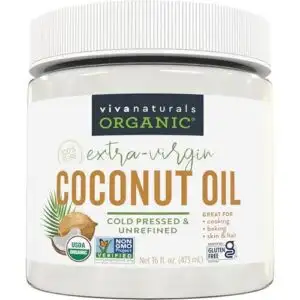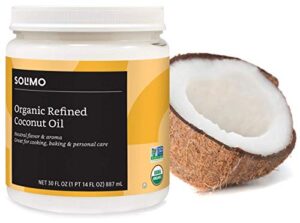This site is supported by our readers. We may earn a commission, at no cost to you, if you purchase through links.
You’ve probably reached for coconut oil at some point—maybe for cooking, maybe for your hair—but grabbed whatever bottle caught your eye without thinking twice. That casual choice matters more than you’d expect.
The coconut oil you pick determines not just how your food tastes or whether your skin gets those promised benefits, but also what you’re actually putting into your body. Refined and unrefined coconut oil look similar on the shelf, yet they’re fundamentally different products shaped by entirely different processing approaches.
Understanding what separates them helps you make intentional choices aligned with how you actually plan to use the oil, whether that’s high-heat cooking, skincare, or something in between.
Table Of Contents
- Key Takeaways
- Refined Vs Unrefined Coconut Oil Overview
- How Coconut Oil is Processed
- Nutritional Profiles Compared
- Cooking and Baking Applications
- Coconut Oil for Skin and Hair
- Top Refined and Unrefined Coconut Oil Products
- Frequently Asked Questions (FAQs)
- Which is better, unrefined or refined coconut oil?
- Can I use unrefined coconut oil instead of refined?
- Should I use refined or unrefined coconut oil on my skin?
- When should I use refined coconut oil?
- How long does coconut oil last before expiring?
- Can I switch between refined and unrefined in recipes?
- Which type is better for weight loss goals?
- Is coconut oil safe for pets to consume?
- How should I store coconut oil at home?
- Conclusion
Key Takeaways
- Refined coconut oil handles high-heat cooking better with a 400–450°F smoke point, while unrefined coconut oil works best below 350°F and retains its strong coconut flavor for curries and traditional recipes.
- The refining process strips away up to 98% of vitamin E and beneficial antioxidants, though both types deliver identical calories (120 per tablespoon) and saturated fat content (around 92%).
- Unrefined coconut oil preserves natural compounds through minimal cold-pressing or wet centrifugation, whereas refined oil undergoes chemical treatment including degumming, bleaching, and high-heat deodorization that creates a neutral taste.
- Your choice between refined and unrefined depends on whether you prioritize cooking versatility and neutral flavor (refined) or maximum nutrient retention and coconut taste for skincare and traditional dishes (unrefined).
Refined Vs Unrefined Coconut Oil Overview
Choosing between refined and unrefined coconut oil doesn’t have to feel like guessing in the dark. Each type has distinct characteristics that affect everything from how it tastes to how it performs under heat.
Let’s break down what sets them apart so you can make the right call for your kitchen and lifestyle.
Key Differences Explained
The main differences between refined and unrefined coconut oil boil down to processing contrasts, flavor profiles, and smoke points. Virgin coconut oil keeps its strong coconut aroma and nutritional variance, while refined coconut oil becomes nearly tasteless through bleaching and deodorizing. Understanding that coconut oil contains MCTs is valuable for those seeking its potential health benefits.
Here’s a quick snapshot of coconut oil types:
| Feature | Unrefined | Refined |
|---|---|---|
| Smoke Point | 350°F | 400–450°F |
| Flavor | Strong coconut | Neutral |
| Processing | Minimal | Chemical treatment |
Understanding these coconut oil differences helps you match the best applications to your needs.
Common Uses for Each Type
Refined coconut oil dominates processed foods and industrial cooking, accounting for over 55% of market use in 2024. You’ll find it in commercial bakeries, snacks, and frying applications thanks to its neutral flavor and high smoke point. Unrefined coconut oil shines in traditional Southeast Asian curries, premium health foods, and natural skincare—about 72% of you use it weekly for beauty routines. It’s a great source of healthy fat, providing 120 calories per tablespoon.
Here’s where each type excels:
| Use Category | Refined | Unrefined |
|---|---|---|
| High-heat cooking | Commercial frying, sautéing | Traditional curries, stews |
| Baking | Neutral-flavored goods | Coconut-forward recipes |
| Personal care | Fractionated skin products | DIY hair treatments |
| Industrial | Biodiesel, surfactants | Wellness supplements |
The culinary versatility of refined oil makes it your go-to for everyday cooking, while unrefined varieties offer skincare benefits and cultural significance in traditional recipes.
Why The Distinction Matters
Your choice between refined and unrefined coconut oil isn’t just about taste—it affects nutritional value, consumer health outcomes, and even regulatory standards compliance. The refining process of coconut oil strips away up to 98% of tocopherols (from 12.39 to 0.10 mg/kg), while oil extraction methods determine which culinary uses suit your needs. Understanding coconut oil processing methods helps you balance processing impact against your cooking goals.
Refining coconut oil strips away 98% of its tocopherols, fundamentally reshaping its nutritional value and culinary performance
| Factor | Why It Affects You |
|---|---|
| Nutrient retention | Refining removes antioxidants your body needs |
| Contaminant risk | Processing may introduce 3-MCPD esters |
| Flavor profile | Impacts recipe success and satisfaction |
| Price point | Unrefined costs more due to specialized sourcing |
How Coconut Oil is Processed
The journey from coconut to oil involves different methods that shape the final product you bring home. Unrefined coconut oil follows a minimal path from fresh coconut meat, while refined oil takes several additional steps to transform its properties.
Understanding these processing differences helps you make sense of what you’re actually getting when you choose between the two.
Unrefined (Virgin) Extraction Methods
Virgin coconut oil production relies on several oil extraction methods that preserve natural quality. Cold-pressing yields 50–60% oil from dried coconut at temperatures below 120°F, maintaining antioxidants. Wet centrifugation achieves higher recovery—up to 70%—by spinning fresh coconut milk at 6,000–8,000 rpm.
Fermentation parameters like 24-hour processing can reach 92.7% extraction. Hydrolysis-assisted techniques hit 98.6% yield, while traditional boiling methods produce just 8–15% due to evaporation losses.
Refined Coconut Oil Processing Steps
Unlike cold-pressed virgin varieties, refined coconut oil—sometimes called RBD oil—goes through an extensive transformation.
Refining coconut oil starts with degumming methods: heating copra to 60–80°C with phosphoric acid removes impurities. Next, bleaching agents like white clay strip pigments at 90–120°C. The final step? Heat-deodorization at 230°C for 90 minutes, producing neutral-tasting oil.
This refining process of coconut oil achieves 98.5% recovery while meeting strict contaminant regulations for safe consumption.
Impact of Processing on Quality
When you choose between refined and unrefined coconut oil, processing fundamentally shifts coconut oil quality in five measurable ways:
- Nutrient loss: Vitamin E drops from 12.39 mg/kg to just 0.10 mg/kg
- Contaminant formation: 3-MCPD esters spike during deodorization
- Bioactive changes: Sterols decline from 680 to 427 mg/kg
- Sensory qualities: Refining strips 90% of aroma compounds
- Shelf life: Peroxide values plummet, boosting stability
Nutritional Profiles Compared
When you’re standing in the grocery store aisle comparing coconut oil bottles, you might wonder if one’s healthier than the other. The good news is that refined and unrefined coconut oil are surprisingly similar with respect to calories and basic fat content.
However, there are some important differences in their nutritional makeup that can help you decide which one fits your needs.
Calorie and Fat Content
Regarding calorie comparison and fat composition, refined coconut oil and unrefined coconut oil are nearly identical twins. You’ll find that each tablespoon delivers about 120 calories and 14 grams of total fat, regardless of type.
Here’s what nutritional labeling reveals:
| Nutrient | Per Tablespoon |
|---|---|
| Calories | 120–121 |
| Total Fat | 14g |
| Saturated Fat | 12–14g |
| Unsaturated Fats | <1g |
Both versions pack around 92% saturated fats—primarily fatty acids like lauric acid—while unsaturated fats remain minimal. The nutrient profiles don’t differ meaningfully between refined and unrefined varieties, so your choice won’t impact your caloric intake.
Medium-Chain Triglycerides (MCTs) and Lauric Acid
Both refined coconut oil and unrefined coconut oil deliver similar medium-chain triglycerides (MCTs), generally 54–65% of total fatty acids. The star player is lauric acid, making up roughly 47–53% across both types—though it’s absorbed more slowly than the shorter-chain MCTs like caprylic and capric acids.
Consumer labeling often reports total saturated fat without specifying lauric benefits or exact MCT composition, so checking third-party analyses helps.
Antioxidants and Contaminants
You’ll notice a striking gap in antioxidants: unrefined coconut oil boasts phenolic content up to ten times higher than refined versions, giving it greater radical scavenging power. The refining process strips away polyphenols and vitamin E, but it also introduces processing contaminants like glycidyl esters and 3-MCPD.
Meanwhile, unrefined coconut oil shows lower metal content and minimal chemical residues, preserving valuable antioxidant types like tocopherols and flavonoids.
Cooking and Baking Applications
When you’re standing in your kitchen deciding which coconut oil to reach for, the cooking method you’re using matters more than you might think. The temperature of your pan, the flavor profile you’re building, and even the type of dish you’re making all influence whether refined or unrefined coconut oil is the better choice.
Let’s break down how each type performs in real cooking and baking situations.
Smoke Point Differences
Think of smoke point as your oil’s heat threshold—the temperature at which it starts breaking down. Refined coconut oil tolerates high heat cooking at 400–450°F, making it suitable for stir-frying and sautéing. Unrefined coconut oil reaches its limit around 350°F, so you’ll want to reserve it for gentler applications.
Heating beyond these cooking temperatures triggers oil breakdown, releasing harmful compounds and creating heating hazards while compromising flavor impact and culinary safety.
Flavor and Aroma Considerations
Unrefined coconut oil delivers pronounced coconut flavor and aroma thanks to up to 44 distinct aroma compounds—primarily lactones and aldehydes that create its signature creamy, tropical character.
Refined coconut oil, by contrast, undergoes heat deodorization that strips away these flavor-active components, leaving you with a neutral, nearly flavorless product.
Your choice hinges on whether you want that coconut presence enhancing your dish or prefer it to stay in the background.
Best Uses in The Kitchen
Your kitchen choice depends on what you’re making. Refined coconut oil shines in five scenarios:
- High-heat cooking like stir-frying and deep-frying
- Baking where neutral flavor won’t compete
- Dairy substitution in savory dishes
- Ethnic cuisine requiring ingredient flavor preservation
- Microwave popcorn and commercial applications
Unrefined coconut oil works best for raw recipes, no-bake energy balls, and dishes where you want that coconut character front and center.
Coconut Oil for Skin and Hair
Beyond the kitchen, coconut oil has become a go-to ingredient for skin and hair care routines. Both refined and unrefined versions offer real benefits, but they’re not interchangeable—each type brings different strengths to your beauty regimen. Here’s what you need to know to pick the right one for your specific needs.
Benefits of Unrefined Coconut Oil
When you choose virgin coconut oil for your skin, you’re getting nature’s multitasker. Clinical trials show unrefined coconut oil reduced atopic dermatitis severity by 68% in just eight weeks—noticeably outperforming mineral oil. Its lauric acid delivers potent antimicrobial action, while high antioxidant levels combat cellular damage. The oil’s occlusive nature locks moisture in, making it ideal for eczema and dry skin. For oral health, the same antimicrobial properties tackle cavity-causing bacteria, supporting your gums naturally.
| Benefit | How It Works | Your Advantage |
|---|---|---|
| Lauric Acid | Fights harmful bacteria | Clearer, healthier skin |
| Antioxidants | Neutralizes free radicals | Reduced inflammation |
| Occlusive Action | Seals in moisture | Improved skin barrier |
| Oral Protection | Inhibits cavity bacteria | Stronger dental health |
Advantages of Refined Coconut Oil
While virgin coconut oil excels at targeted skin benefits, refined coconut oil brings practical advantages to your beauty routine. Its processing removes allergens and contaminants, making it gentler for sensitive skin. The neutral flavor profile suits cosmetic formulations better, and improved shelf stability means your product won’t degrade quickly. Here’s what refined coconut oil delivers:
- Allergen reduction for reactive skin
- Consistent purity across formulations
- Extended shelf life without rancidity
- Cost-effectiveness for regular use
- Hygienic profile for sensitive applications
Choosing The Right Oil for Beauty
How do you know which oil suits your skin and hair needs? Your decision hinges on sensitivity and desired benefits. Unrefined coconut oil excels at intensive hydration and hair strengthening, though it carries higher allergenic compounds. Refined coconut oil works better for sensitive skin and makeup removal, offering gentler, contaminant-free options. Consider your skin type, application goals, and any coconut allergies when selecting your beauty product.
| Factor | Unrefined | Refined |
|---|---|---|
| Skin Hydration | Higher (68% improvement) | Moderate |
| Hair Strength | 32% increase | Standard |
| Dandruff Reduction | 70% improvement | Effective |
| Allergenic Compounds | Higher risk | Minimal risk |
Top Refined and Unrefined Coconut Oil Products
Now that you know the differences between refined and unrefined coconut oil, you’re probably wondering which products are actually worth buying.
We’ve rounded up some of the top options that deliver on both quality and value, whether you’re cooking, baking, or looking for beauty applications.
Here are the products that stand out in each category.
1. Viva Naturals Organic Coconut Oil
Viva Naturals stands out as a top-selling unrefined coconut oil brand, using cold-pressed extraction to preserve natural phytonutrients and antioxidants. Its USDA Organic certification ensures freedom from synthetic pesticides, while its nutritional composition delivers 130 calories and 14 grams of fat per tablespoon, with lauric acid comprising roughly 45–50% of total fats.
Clinical research confirms its skin applications, showing improvements in elasticity within weeks without irritation.
The brand’s market standing reflects consistent consumer trust through third-party certifications.
Best For: Anyone looking for a versatile, organic coconut oil that works equally well in the kitchen, on skin and hair, or as a natural wellness tool—especially those who want certified organic and cold-pressed quality without additives.
- Cold-pressed and unrefined, so it keeps natural antioxidants, phytonutrients, and lauric acid that refined versions lose during processing
- USDA Organic and Non-GMO certified with no synthetic pesticides, artificial fragrances, or added preservatives, plus clinical studies show it doesn’t irritate skin or trigger acne
- Genuinely does what it promises—improves skin elasticity, reduces hair dryness and protein loss, and actually works for cooking, oil pulling, and makeup removal without being a gimmick
- Solidifies when it gets cold, which is annoying if you’re trying to scoop it out or store it in a small space
- The coconut smell is strong and definitely not for everyone, especially if you’re sensitive to it or want something more neutral-smelling
- Independent testing found phthalate contamination levels in some unrefined coconut oils, and the jar itself is bulky to fit in smaller pantries or cabinets
2. Happy Belly Organic Refined Coconut Oil
Happy Belly delivers a refined coconut oil that prioritizes neutral flavor and culinary versatility. Its processing methods—steam refining and calcareous clay filtration—strip away coconut taste while maintaining the nutritional purity you’d expect from organic certification.
With a higher smoke point of 400–450°F, it excels at high-heat cooking. Product specifications include zero trans fats and dairy-free composition, making it ideal for both kitchen applications and beauty routines while offering consumer usage flexibility at competitive pricing.
Best For: Home cooks and bakers who want a versatile, neutral-tasting coconut oil for high-heat cooking, plus anyone looking for an affordable organic option that doubles as a skincare staple.
- Neutral flavor and aroma make it perfect for any dish without overpowering coconut taste, and the 400–450°F smoke point handles serious cooking without breaking down.
- USDA organic certified with zero trans fats and no artificial additives, hitting the sweet spot between health-conscious shopping and competitive pricing around $15.
- Works beyond the kitchen—solid at room temperature, so it’s easy to use for baking, beauty routines, and DIY personal care projects.
- Melts to liquid above 75°F and hardens when it cools, which can be annoying if you prefer consistent texture or live somewhere warm.
- Trace amounts of phthalates show up in all tested coconut oils including this one, even though levels are low and within regulatory limits—not a dealbreaker but worth knowing if you’re sensitive to contaminants.
- Refined processing strips the coconut flavor, so if you actually want that coconut taste in your food or recipes, this won’t deliver it.
3. Alba Botanica Hawaiian Coconut Sunscreen Spray
Alba Botanica Hawaiian Coconut Sunscreen Spray combines coconut oil and broad-spectrum SPF 50 protection, enriched with botanical hydrators like aloe and safflower oil. Its air-powered spray technology allows for application at any angle and provides 80-minute water resistance, making it suitable for daily outdoor activities.
However, consumer feedback highlights concerns with the spray functionality, as caps may break after limited use. Additionally, while the product is marketed as reef-safe, there is ongoing scrutiny regarding its avobenzone content. For those with sensitive skin, patch testing is recommended.
Best For: People who want effective, broad-spectrum sun protection with natural ingredients for daily use and water sports, but are willing to accept potential spray functionality issues and environmental trade-offs.
- SPF 50 broad-spectrum protection with 80-minute water resistance, backed by strong lab testing and recommended by the Skin Cancer Foundation
- Lightweight, quick-drying formula with natural moisturizers like aloe and avocado oil that won’t leave you feeling greasy
- Air-powered spray technology lets you apply at any angle, making it convenient for hard-to-reach areas and quick touch-ups
- The spray mechanism is unreliable—caps break easily and the nozzle frequently stops working after minimal use, which is a common complaint
- Despite marketing as reef-safe, it contains avobenzone and octocrylene, which have been shown to harm marine life and are banned in some places
- Some users report it feels sticky or greasy despite claims of a lightweight texture, and those with sensitive skin should patch test first due to potential allergens
Frequently Asked Questions (FAQs)
Which is better, unrefined or refined coconut oil?
Neither is objectively “better”—it depends on your needs. Unrefined retains more antioxidants and flavor, ideal for baking and raw uses.
Refined performs better in high-heat cooking with its neutral taste. Choose based on your application and whether you want coconut flavor present.
Can I use unrefined coconut oil instead of refined?
Yes, you can substitute unrefined for refined coconut oil in most situations, but watch your cooking temperature. Unrefined’s 350°F smoke point limits it to medium-heat cooking, while refined tolerates up to 450°F.
You’ll also notice a significant flavor impact and retain more nutrients with unrefined.
Should I use refined or unrefined coconut oil on my skin?
Your skin type determines the best choice. Unrefined coconut oil hydrates dry skin effectively and offers greater antioxidant benefits, though it may clog pores in acne-prone individuals.
Refined coconut oil works better for sensitive skin due to lower irritation risks, though it has reduced antioxidant content.
When should I use refined coconut oil?
Think of refined coconut oil as your adaptable kitchen workhorse—ideal for high-heat cooking, baking where neutral flavor is needed, and industrial applications.
Its 400°F smoke point, cost effectiveness, and extended shelf-life make it practical for everyday culinary use.
How long does coconut oil last before expiring?
Unrefined coconut oil generally lasts three to five years when stored properly in cool, dark conditions, while refined varieties remain shelf-stable for eighteen to thirty-six months.
Proper storage in airtight containers away from light and heat extends freshness and prevents rancidity.
Can I switch between refined and unrefined in recipes?
You can switch between refined and unrefined coconut oil in most recipes with similar results.
The main considerations are smoke point—refined tolerates higher heat better—and flavor impact, since unrefined imparts coconut taste while refined stays neutral in your dishes.
Which type is better for weight loss goals?
Both refined and unrefined coconut oil contain identical MCT content and calorie density—120 calories per tablespoon. Clinical studies show modest weight loss results when either type replaces dietary fats within a calorie-restricted diet.
The key difference: unrefined oil retains antioxidant components that may improve metabolic benefits, though long-term superiority remains unproven.
Is coconut oil safe for pets to consume?
Coconut oil poses risks for pets when consumed orally. Dosage guidelines recommend starting small, yet adverse effects like diarrhea, pancreatitis, and weight gain occur frequently.
Topical safety is better established. Veterinary consensus advises consulting your vet before use, especially for pets with existing health conditions.
How should I store coconut oil at home?
Store your coconut oil like treasure in a dark glass bottle, kept in a cool pantry away from heat and light.
Sealed containers prevent rancidity; aim for temperatures below 75°F to maintain shelf life. Refrigeration isn’t necessary for this shelf-stable oil.
Conclusion
The best coconut oil isn’t always the “purest” one sitting on the shelf. Refined coconut oil excels where unrefined stumbles—your high-heat stir-fries and baking projects need its stability, while unrefined delivers the nutritional density your skincare routine craves.
The refined vs unrefined coconut oil choice hinges on context, not flawlessness. Match the oil to your actual need, and you’ll skip the buyer’s remorse that comes from reaching for yesterday’s mistake.
- https://www.foodnetwork.com/how-to/packages/food-network-essentials/refined-vs-unrefined-coconut-oil
- https://www.gyros.farm/blogs/know-what-you-eat/refined-vs-unrefined-coconut-oil
- https://www.kimbertonwholefoods.com/decoding-coconut-oil/
- https://www.eatthismuch.com/calories/organic-unrefined-coconut-oil-539185
- https://pmc.ncbi.nlm.nih.gov/articles/PMC10660992/













